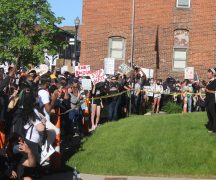BY DAVID DEWITT
Oct. 5, was the 209th anniversary of the killing in battle of Ohio Shawnee chief Tecumseh, born near Chillicothe in 1768. His efforts to build a permanent territory for a confederacy of Indigenous American tribes, bordered by the Great Lakes in the north, the Ohio River in the east and south, and the Mississippi River in the West, were thus forever dashed.
The death of Tecumseh, and with him his dream of a Native American nation on this continent, removed the primary resistance to America fully establishing the states of Ohio, Indiana, Illinois, Michigan, and Wisconsin.
The story of Ohio’s founding is the story of the then-northwestern frontier and what’s known to historians as the Ohio Indian Wars, wrapped up in the American Revolution, the War of 1812, and the intertwined conflicts between America, Britain, and France.
The stage for the many battles over the Ohio country was set by the Beaver Wars, which began in the mid-17th Century when the Iroquois Confederacy launched a war for control of the burgeoning fur trade industry.
At the time, a tribe known as the Erie controlled Ohio territory along the lake. By the time the Treaty of Grande Paix of Montreal was signed in 1701 by the British, the French, the Iroquois Confederacy, and the tribes of the Great Lakes, the Erie had been wiped out, either killed or absorbed into nearby Iroquois tribes to the east.
The defeat and destruction of the Erie led to Ohio country becoming devoid of many significant, permanent Indigenous inhabitants. Other displaced nations moved into the territory, such as the Shawnee, Miami, Wyandots, Lenape, and others, establishing settlements and systems of travel recognizable by their names today.
The name Ohio itself comes from the Seneca Iroquois word, “ohi:yo’” meaning “great river.” This makes the Ohio River the Great River River.
Rivers were the highways of the day, so in addition to Lake Erie, we see many of our waterways bearing Indigenous nomenclature: the Scioto (native word for deer), Maumee (anglicized spelling of the Ottawa name for the Miami Tribe), Miami (the Miami tribe), Olentangy (Wyandot for, “River of Red Face Paint”), Mohican (Algonquian-speaking Muh-he-con-neok tribe originating from the upper Hudson Valley in present day New York. Their name means, People of the Waters That are Never Still).
The list of Ohio places with native names are too many to list in full with explanations, but here’s a sample: Ashtabula, Coshocton, Cuyahoga, Erie, Geauga, Hocking, Licking, Mahoning, Miami, Muskingum, Pickaway, Sandusky, Scioto, Seneca, Tuscarawas, and Wyandot counties, along with the cities and villages of Chillicothe, Piqua, Pataskala, Conneaut, Ashtabula, Mingo Junction, Wabash, Wapakoneta, Shawnee Hills, Chippewa Lake, Chickasaw, Catawba Island, and a whole lot more.
Other places are named after frontiersmen and American leaders of the time such as Kenton being named for Simon Kenton, and St. Clairsville being named for Northwest Territory Gov. Arthur St. Clair.
The rise of Tecumseh

Tecumseh came of age amidst the French and Indian War, and in 1774, at the Battle of Point Pleasant during Lord Dunmore’s War removing the Shawnee from Kentucky, his father was killed.
By all accounts athletic, smart, dutiful, and charismatic, Tecumseh vowed to become a warrior like his father and joined the native confederacy under Mohawk Chief Joseph Brant.
By the end of the Revolutionary War, many native peoples had been pushed out of the eastern portion of Ohio, but remained in the central and western portions, including the Shawnee and Tecumseh.
Tecumseh led raids on American boats making their way down the Ohio River, and later, in 1791, he further established himself at the Battle of the Wabash near Fort Recovery, Ohio, a crushing defeat of General Arthur St. Clair that forced St. Clair to resign.
The native confederacy suffered a crushing defeat of their own in 1794 at the Battle of Fallen Timbers along the Maumee near Toledo. After the battle, about 250 warriors stayed with Tecumseh and followed him to what would become Prophetstown, near the confluence of the Tippecanoe River and the Wabash River, now commemorated as Prophetstown State Park in West Lafayette, Indiana.
“The Prophet” of Prophetstown was not Tecumseh, but his brother Tenskwatawa.
Ohio became the 17th state with a Feb. 19, 1803 act of Congress. (Statehood is celebrated on March 1 because March 1, 1803, was when the Ohio legislature met for the first time in the then-capital, Chillicothe.)
In 1808, Tecumseh and Tenskwatawa began assembling a large, multi-tribal band of followers under a message of resistance to settlers, the American government, and assimilation.
While Tenskwatawa took up the role of “Prophet” spiritual leader predicting a new Indigenous nation, Tecumseh served as ambassador, traveling up to Canada, as well as down south to areas such as Alabama to recruit tribes to join their confederacy of native peoples.
William Henry Harrison
Meanwhile, Indiana Territory Gov. William Henry Harrison was organizing American forces to put down the Indigenous resistance to settlement. He made a series of treaties with various tribes capturing Indiana territory, and in 1809, Harrison signed the Treaty of Fort Wayne with the Delaware, Miami, Kickapoo and others, but not the Shawnee. In it, he took large swaths of native territory and spurred Tecumseh and Tenskwatawa to double-down on their efforts. Tecumseh urged other tribes to flout the treaty and join his resistance at Prophetstown. As he was amassing forces, he avoided direct conflict with the United States, attempting to build his strength first.
In 1810, Tecumseh met with Harrison at Harrison’s Vincennes, Indiana, home Grouseland (The Vincennes and Grouseland treaties are others Harrison signed to capture Indiana territory land). Tecumseh offered loyalty to America if the Fort Wayne Treaty lands were returned. If they were not, Tecumseh told Harrison he would seek alliance with the British, with whom he had been reluctant to ally as he saw the British as using native forces on the frontier for their own ends. Harrison scoffed at the idea of common native ownership of lands, asserting that the U.S. had separate treaties with separate tribes for separate lands.
After the meeting, rebuffed, Tecumseh continued building alliances with other native tribes. Harrison meanwhile began appealing to Washington, D.C., to launch an all-out war against the native confederacy. In the summer of 1811, Harrison and Tecumseh met again, at Harrison’s request. That meeting was as unproductive as their first, and Tecumseh told Harrison, and later Tenskwatawa, that he would be travelling and wanted “no mischief” while he was away, so that when he returned they could resume negotiation over the disputed lands.
Battle of Tippecanoe
Harrison received word from U.S. Secretary of War William Eustisthat peace should be preserved unless Tenskwatawa attacked. Harrison then sent Tenskwatawa a series of letters making demands. He accused the Shawnee of murder and stealing horses, and ordered non-Shawnee residents out of Prophetstown. Tenskwatawa only offered to return horses. Harrison began to assemble an army of soldiers, gathering about 1,000.
While they were camping outside Fort Harrison, a guard was shot, and Harrison considered this an act of aggression giving him cause to come down hard on Prophetstown, writing to Eustice of Tenskwatawa, “Nothing now remains but to chastise him.”
Harrison’s forces approached Prophetstown on Nov. 6, 1811, and camped on Burnett’s Creek. What happened next is murky. A Kickapoo chief said that the shooting of two Winnebago warriors by sentries aroused the indignation of the people of Prophetstown, while Tenskwatawa himself in 1816 blamed Winnebago warriors for launching an attack on Harrison’s camp.
Regardless of how it began, during a night council meeting Nov. 6 Tenskwatawa seems to have agreed to a preemptive strike, and is said to have offered to cast spells to prevent native warriors from being harmed. In the pre-dawn hours of Nov. 7, 1811, Harrison’s sentinels encountered advancing native warriors, and the Battle of Tippecanoe began. The Indigenous efforts were scattershot and disorganized, and after about two and half hours, they retreated to Prophetstown and confronted Tenskwatawa, who offered to cast new protection spells and encouraged another attack.
His fellows did not take him up on that, and Prophetstown was abandoned overnight. On Nov. 8, Harrison rolled into Prophetstown with his forces and burned it to the ground. This was a severe blow to the native confederacy, and launched Harrison into national fame. In 1840, Harrison ran for president and won with running mate John Tyler under the slogan, “Tippecanoe and Tyler too.”
Tecumseh was reportedly furious with Tenskwatawa for losing the battle and making the attack in the first place. Prophetstown was partially rebuilt, but violence increased on the frontier after the battle.
As ambassador, Tecumseh told many tribes he visited of a sign that would come telling them it was time to fight.
Many took a series of earthquakes in the South and Midwest in December 1811 — known as the New Madrid earthquakes, which are the biggest in American history — as that sign.
More violence ensued.
War of 1812
On June 1, 1812, at President James Madison’s request, Congress declared war on Great Britain. This had to do with disputes over territorial expansion, especially in the Northwest Territory, and Britain’s restriction of trade with France and impressment of American citizens as British subjects.
Native peoples were split, but Tecumseh and his confederacy sided with the British.
Assigned to take over the city of Detroit, the siege was a success in large part due to Tecumseh’s military thinking and strategy. A similar siege of Fort Meigs failed, however, and morale waned.
In the fall of 1813 as conditions around Detroit worsened, the British began to retreat east, but Tecumseh requested arms to stay in the Northwest Territory and continue to defend native lands.
The British agreed to make a stand in Ontario near the northern shore of Lake Erie, but communication broke down and so did the unity of forces, with some defecting, some staying, and others continuing to travel east.
When Americans attacked, about 500 native confederate warriors including Tecumseh were left to try to hold back 3,000 American soldiers. Tecumseh was killed in the battle. Nobody knows exactly how, or what happened to his remains.
The death of Tecumseh largely dismantled the confederacy of tribes he had established, and their alliances broke down. The removal of Indigenous peoples from the Upper Midwest then continued apace, and Tecumseh’s dream of a Native American nation evaporated. In Ohio, obviously, we are living where it would have been.
Further reading
This has been a woefully concise overview of Tecumseh and his life and influence.
Many entire books have been written on these events, with much more color and detail than this space affords me here.
Below is a list of my personal recommendations for further reading:
- Tecumseh: A Life, by John Sugden
- A Sorrow in Our Heart: The Life of Tecumseh, by Allan W. Eckert
- Tecumseh and the Prophet: The Shawnee Brothers Who Defied a Nation, by Peter Cozzens
- The Worlds the Shawnees Made: Migration and Violence in Early America, by Stephen Warren
- Panther in the Sky: A Novel Based on the Life of Tecumseh, by James Alexander Thom (historical fiction)
- The Frontiersmen, by Allan W. Eckert (historical fiction)









